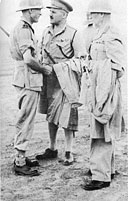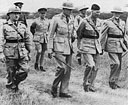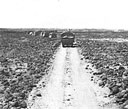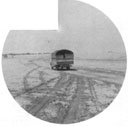
2
General Smuts fulfils his promise
At Zonderwater, 1st S.A. Infantry Brigade Group had had transport sufficient for one motorized battalion issued to it a few days before Italy's declaration of war and on the night of 10 June, the 1st Transvaal Scottish, as duty battalion, was ordered to Komatipoort on the Lourenco Marques-Pretoria railway line, right on the Portuguese East African border. With 10th Field Ambulance, S.A.M.C. (Lieut.-Colonel D. B. Strachan) having only one company at Zonderwater, as the rest were on their way to Kenya, 11th Field Ambulance, S.A.M.C. (Lieut.-Colonel G. D. English) had to draw transport hurriedly to move 'A' Company to Nylstroom and the rest of the unit to Komatipoort on 12 June. As the Transvaal Scottish hurried eastward, the Dukes were also given orders to move.
Colonel J. G. Rose, Director of Transport, commandeered transport from the Military College during the night and --to quote the regiment's own history--'in this the battalion solemnly rounded the brigade's own tuckshop, the Black Cat Cafe, and returned to its quarters!'1 Meanwhile, the Transvaal Scottish had secured the village, the railway station and causeway at Komatipoort and within 48 hours the 'OJ Services Corps had established supply dumps. A detachment was left to garrison the border post and the Transvaal Scottish returned to Premier Mine,2 having learned some valuable lessons about movement by road.
The exercise, in the opinion of higher authority, had not proved an outstanding success. On 19 June, just one month after the brigade had been mobilized, Colonel D. H. Pienaar, a Permanent Force gunner officer, took over command, his appointment back-dated to 12 June.
Meanwhile the infantry component of the under-strength Field Force Brigade was completed by the mobilization of 1st Battalion, Natal Mounted Rifles (Lieut.-Colonel N.D. McMillan, V.D.). Colonel F. L. A. Buchanan, M.C, V.D., who had been in command of the peace-time 9th Infantry Brigade at the outbreak of war, had vacated the post of Deputy Director of Infantry Training at Premier Mine to assume command of the Field Force Brigade before the mobilization of the 1st S.A. Infantry Brigade. He now became Commander of what was redesignated 2nd S.A. Infantry Brigade as from 25 June 1940. As his Brigade Major, Colonel Buchanan had Major Eugene Maggs.
The first battalions of the Imperial Light Horse (Lieut.-Colonel




